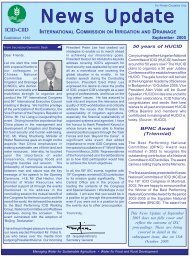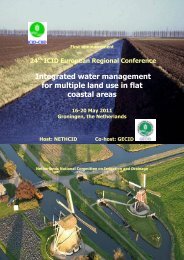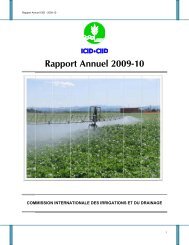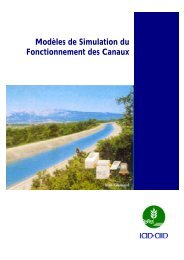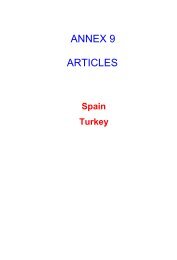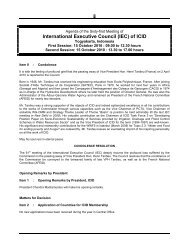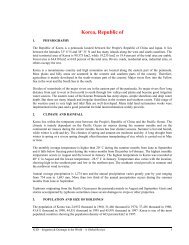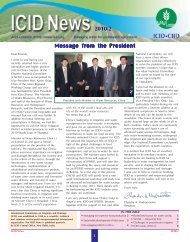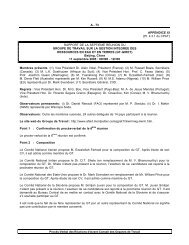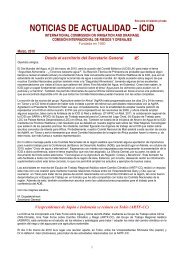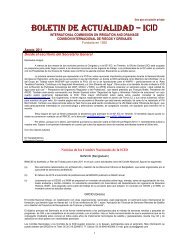Water Administration System (WAS)
Water Administration System (WAS)
Water Administration System (WAS)
Create successful ePaper yourself
Turn your PDF publications into a flip-book with our unique Google optimized e-Paper software.
<strong>Water</strong> <strong>Administration</strong> <strong>System</strong> (WAS)1.1 PURPOSE OF THE WAS PROGRAMThe <strong>Water</strong> <strong>Administration</strong> <strong>System</strong> (WAS) is designed to be a water management tool for irrigationschemes, <strong>Water</strong> User Associations (WUA’s), Catchment Management Agencies (CMA’s) and watermanagement offices that want to manage their water usage, water distribution and water accounts.The main aim during the development of the WAS program was to minimise water losses for irrigationschemes that work on the demand system and that distribute water through canal networks. Currentlythe WAS program is in use at all the major irrigation schemes cross South Africa and it manages anirrigated area of more than 142 000 ha including 9 500 farms. The main benefits of using the WASprogram is:• The minimising of water distribution losses.• The excellent management of water quota allocations and water usage per farmer.• The availability of an extensive list of water reports on farm and scheme level.• The increased productivity of scheme management personnel.• An integrated debit accounting system that improves debit management.• The improvement of the overall water administration management on irrigation schemes.Table 1: Irrigation schemes where the WAS program is usedIrrigation SchemeArea(ha)Quotaallocation(m 3 /ha)Full quota(m 3 )AbstractionpointsYears inuseImpala <strong>Water</strong> Users Association 17,012 10,000 170,120,000 423 10Gamtoos Irrigation Board 7,408 6,000 44,448,000 808 3Groenland Irrigation Board 5,864 6,000 35,184,000 146 6Hartbeespoort Irrigation Board 13,915 6,200 86,273,000 1,721 9Hereford Irrigation Board 3,425 7,700 26,372,500 53 3Korentte Vetteriver Irrigation Board 852 7,000 5,964,000 121 4Lower Olifants River WUA 9,212 12,200 112,386,400 1,415 10Loskop Irrigation Board 16,135 7,700 124,239,500 794 15Groot Marico Government <strong>Water</strong> Scheme 2,523 5,300 13,371,900 309 5Mooiriver Government <strong>Water</strong> Scheme 4,954 7,700 38,145,800 603 12Orange Riet WUA 15,941 11,000 175,351,000 679 6Sandvet Government <strong>Water</strong> Scheme 10,542 1,080 11,385,360 616 10Vaalharts WUA 35,060 9,140 320,448,400 1,873 12Totals 142,843 1,163,689,860 9,561The WAS database can handle any number of abstraction points and measuring stations on canalnetworks, pipelines and rivers.1.2 TYPES OF APPLICATIONWAS is an integrated database driven system with many water management capabilities. WAS canbe implemented in a small water office that manages a few abstractions and measuring stations up toa CMA level that manages thousands of abstractions and measuring stations. WAS is used for theefficient administration of:• Address information.• Scheduled or rateable areas.• <strong>Water</strong> quota allocations.• <strong>Water</strong> delivered through pressure-regulated sluice gates, measuring structures and water
meters.• <strong>Water</strong> transfers between users (Automatic and manually).• <strong>Water</strong> use calculations for planted areas based on crop water use data.• Date and time related flow data collected from electronic loggers or mechanical chartrecorders.• Discharge tables (DT) to do conversions between water depth and flow rate for measuringstructures or vice versa.• List of rateable areas (LRA) information.• Calculation of water releases for water distribution through canal networks, pipelines andrivers taking lag times, evaporation, transpiration and seepage into account.• Billing system that links to the water usage information.• Flexible user charges based on water usage, a flat rate or scheduled area.• Images and photos that can be linked to different types of information in the database.• Automatic weather station database with a build in calculation of Eto values.• Mail merge facility for sending letters to clients.The WAS program saves all information in a Firebird database that can be installed on a single PC oron a server for use over a network. This makes it possible for the scheme manager, accountspersonnel and water office personnel to access the database from PC's in their own offices. There isno limitation on the number of PC's that can be linked to the database.What makes the WAS program unique is the fact that it is an integrated system that includes the waterallocations, water use, water distribution and billing information. WAS will generate monthly invoicesautomatically using water usage or scheduled areas information captured in the database. Differentuser names and passwords can be used to control access to certain information in the database.1.3 MODULESWAS consists of five modules that are integrated into a single program that can be used on a singlePC or a multi-user environment. These modules can be implemented partially or as a whole,depending on the requirements of the specific scheme or office. The five modules are:WAS<strong>Administration</strong>module<strong>Water</strong> RequestModule<strong>Water</strong> ReleaseModuleCrop <strong>Water</strong> UseModule<strong>Water</strong> AccountsModule<strong>Administration</strong> moduleThis module is used to administer the details of all water users on an irrigation scheme. Informationmanaged by this module includes addresses, notes, cut-off list, images/photos, list of rateable areas,scheduled areas, household and livestock pipes installed on canals, industrial water quotas, crops andareas planted and crop yields. The administration module must be implemented before any othermodule can be used.<strong>Water</strong> request moduleThis module is used to administer water abstractions from canal networks, pipelines and rivers and itkeeps track of water quota allocations and water usage. <strong>Water</strong> abstractions can be captured in threedifferent ways.• Standard water request forms such as the ones currently used by the Department of <strong>Water</strong>Affairs and Forestry and a few irrigation boards and water user associations. Provides fororiginal requests, additional requests and cancellation of water.• Meter readings that can be captured on a weekly or monthly basis. The end reading of theprevious period is automatically transferred to the start reading of the current period.• Date and time related data that can be imported from electronic data loggers. <strong>Water</strong> usagecan be calculated between specified date and time ranges.
The water request module also has extensive water reporting capabilities such as:• <strong>Water</strong> balance sheet per abstraction.• <strong>Water</strong> balance report that can summarise the water usage per abstraction and all theabstractions per farmer.• <strong>Water</strong> usage per month report.• Operator defined water reports to compile weekly, monthly, quarterly and yearly water usagereports.Most of the water reports have extensive find, sort and filtering capabilities. Abstraction points can belinked in such a way that water is transferred from a master to an extension automatically. There is nolimit to the number of extensions that can be linked to a master.Crop water use moduleThe main function of the crop water use module is to calculate the water usage per crop between twospecified dates for all the planted crops on a scheme based on the plant date, the area planted andthe crop water use curve. The crop yield (ton/ha) can be captured at the end of a growing seasonwhich is used to calculate the total yield (ton) and the yield in (g/m 3 ). A summary of water used for aspecified period can easily be generated per crop type. All the crop water use information can easilybe linked to a geographic information system (GIS) via ODBC and the Land ID field in the crop wateruse module.<strong>Water</strong> accounts moduleThis module links with the water request module and administers all water accounts for an irrigationscheme or water management office. The water accounts module is a full debit system, from whichmonthly reports can be printed, including invoices on pre-printed stationery, reconciliation reports, ageanalysis and audit trail reports.<strong>Water</strong> release moduleThis module links with the water request module and calculates water releases for the main canal orriver and all its branches and tributaries allowing for lag times and any water losses and accruals. Aschematic layout of the total canal network or river system is captured with detail such as the crosssectionalproperties, positioning of sluices or pumps, canal or river slope, structures and canal or rivercapacities. Discharges are converted to the corresponding measuring plate readings where needed.<strong>Water</strong> distribution sheets can be printed for canal or river systems.1.4 WATER SAVINGSMany years of research went into the development of the WAS program with its main aim to minimizewater losses on irrigation schemes. Field measurements indicated water savings of between 10 to 20percent on implementing the water release module of the WAS program alone. Big water lossreduction on an irrigation scheme points towards previous bad water management practices and thisis a very sensitive issue on irrigation schemes in South Africa. The WAS program is thereforeimplemented systematically without publishing any water loss improvements.The different modules of the WAS program can be implemented partially or as a whole, depending onthe requirements of a specific scheme. It makes therefore sense to implement the modules thatmakes the biggest difference first.It is also important to emphasize that a computerised water management system like the WASprogram prevents human errors that can lead to potentially huge water losses. Feedback from WASusers at training courses indicates that after converting, it is considered impossible to manageirrigation schemes without the use of the WAS program.



